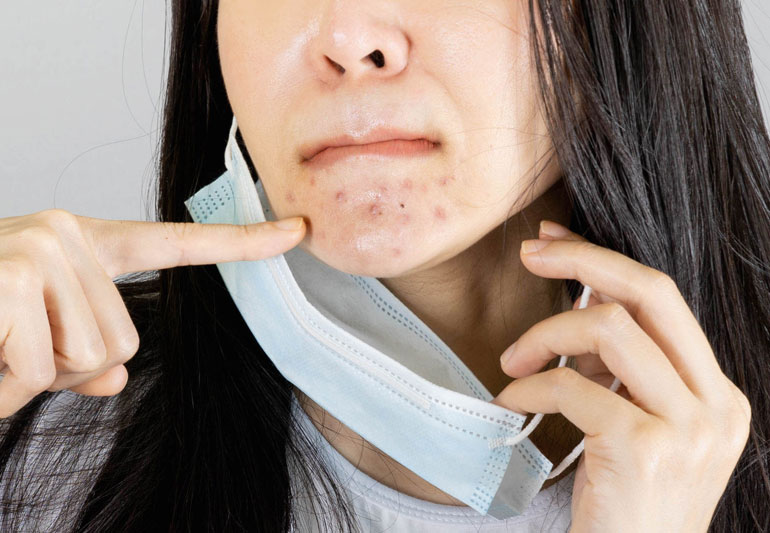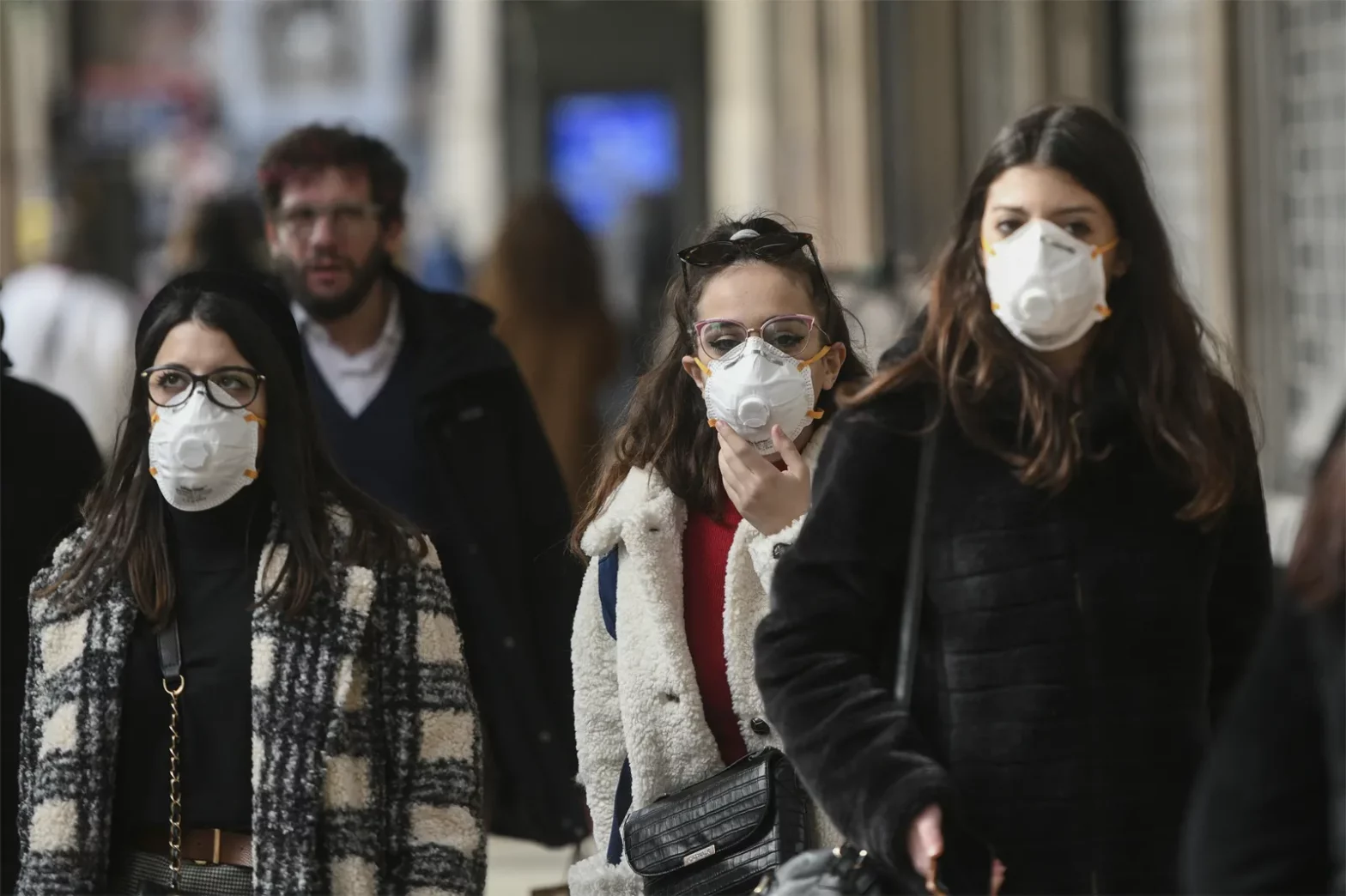These maskne prevention advice could be helpful as you’ll probably need to continue wearing a face mask in public for the foreseeable future.
After each usage, wash fabric masks
At least once per day, wash each mask. Use your usual washing machine and a program that is appropriate for the cloth. Use hypoallergenic, odorless washing detergent, then allow it to fully dry. To avoid mold growth, place damp or filthy face masks in a plastic bag and wash them as soon as you can.

Additionally, always wash or sterilize your hands before donning and after removing a mask.
Use an antibiotic cream topically
Under a mask, germs may accumulate often, which can result in acne. Dermatologists frequently advise doing so before putting on your face mask in order to prevent this from happening. On over-the-counter choices, a pharmacist may provide advice.
In the event of a bacterial illness, a doctor could advise stronger solutions or oral antibiotics.
Throw away single-use face masks after each usage
Throw away a disposable mask after using it. In case you need a new face mask, think about having several on hand.
Face masks should be disposed of properly since research indicates that they are contributing to an increase in plastic pollution. According to one estimate, 1.56 million face masks will have made their way into the waters by 2020.
Every four hours take off your mask
Every four hours, the American Academy of Dermatology Association advises taking off your mask for 15 minutes. Your skin will benefit from a vacation from this.
Only when you can maintain physical distance from persons who aren’t members of your family should you take off your face mask. Apply moisturizer before to using a mask and wash your hands before taking a break from it.
If you have dry skin, a mask could irritate it. Your skin may get more moisturized by using a non-comedogenic moisturizer. Your skin and the mask may be separated by using a moisturizer.
Pick the appropriate mask
Think carefully about the sort of mask you use to prevent skin problems.

Try to use a face mask that meets the following criteria: fits snugly but not too tightly; has two or more layers of fabric; is constructed of natural, soft fabric, such as cotton; and includes a wire at the top to prevent air from seeping through.
Avoid using face masks made of synthetic materials like rayon or nylon. These substances may cause skin irritation. Click here to read about What you need to know about your face mask’s most common skin disorders.
When you take off a mask, wash your face
When you go home, use a mild cleanser to wash your face. Apply a moisturizer afterward to preserve your skin. It’s particularly crucial to wash your face after perspiring while wearing a mask.
Treating certain ailments
- To treat allergic responses, use a mild to moderate strength corticosteroid, such as hydrocortisone 1% ointment.
- You may need to take an antibiotic treatment if an infection develops.
- A doctor may advise frequent use of an antifungal shampoo (such as ketoconazole 2%Trusted Source), a brief course of moderate topical corticosteroids (1% hydrocortisone), or both for seborrheic dermatitis.
- For mild instances of rosacea, a doctor may advise using an ivermectin 1%Trusted Source topical cream once a day, or they may suggest antibiotics for more severe symptoms.
- Gentle daily cleaning with a soap-free cleanser, gentle exfoliation to remove ingrown hairs, and wet rather than dry shaving are suggestions for treating folliculitis. If testing show a bacterial infection, a doctor may provide antibiotics in addition to a mixed steroid and antimicrobial cream.
Here are some more suggestions
For people who use surgical face masks and respirators:
- Pay attention to instructions for resting while using a particular kind of mask, since they might change.
- Give the mask plenty of time to settle in so that it creates a seal without being overly tight.
- If your schedule does not allow for enough breaks and you have a skin issue, go to your supervisor. They may be able to assist.
- Enquire about alternative-component masks that will help you avoid triggers.
- Emollient should be applied lightly at least 30 minutes before to wearing face PPE.
- Use a silicon barrier on the skin that is delicate, such as the cheeks.
- To cover the region and maintain the mask seal when there is damaged skin, use a silicon-backed dressing on the cheekbones and nasal bridge.
- Be sure to have enough water to keep hydrated.
A lot of people have questions
These are some common queries about maskne.
How can Maskne be stopped?

Giving your skin a break by removing the face masks for 15 minutes every 4 hours is one way to prevent maskne. Another is to wash your face often with gentle skin care products.
- wherever feasible, using a soft fabric mask since they are less prone to create friction.
- cleaning reusable masks often or replacing disposable ones; • seeking consultation from a dermatologist if symptoms are severe.
What cosmetics are effective for maskne?
Depending on the situation at hand and the kind of mask you’ll need to wear, this will happen.
Use a mild cleanser twice daily, use an emollient or silicon barrier cream to help minimize friction and the effect of humidity, use products with active components like salicylic acid or benzoyl peroxide, or see a doctor about treatments for more severe symptoms. Obtaining the proper care for certain ailments, such as rosacea, dermatitis, or severe acne.
Are reusable or disposable masks preferable?
Disposable masks are required for certain specialists, but whether reusable or disposable masks are better for the general public is up for discussion.
It’s crucial to strike a balance between comfort and functionality, as one 2020 study.
While pleated, reusable face masks tend to be more successful at controlling heat and humidity, disposable masks seem to be better at allowing air through.
Overall, it seems that the following face masks will likely be the most breathable:
- washable
- have an excellent permeability filter that enables vapor to diffuse;
- are composed of thin, low-density fabric
According to the authors, the fit is likely the most crucial element in keeping particles from flowing through while lowering humidity, which may cause skin issues.
Can you get maskne wearing a fabric mask?
It’s crucial to strike a balance between creating a barrier and lowering the humidity that might exacerbate skin issues.
When possible, the British Skin Foundation advises those who are prone to acne and other skin conditions to wear cott on face masks. These have a lower propensity to create friction or retain moisture.
According to one research, a mask consisting of a cotton sheet that is 300 threads per inch in density may provide at least 79 percent protection and even more if it also contains silk or chiffon.
The way the mask fits and how often you wash and replace it are further considerations. The danger of dampness may be increased by a tight fit, and the chance of infection may also be increased by erratic washing. Visit https://medlineplus.gov/ency/imagepages/19946.htm to read about How to wear a face mask to prevent the spread of COVID-19
